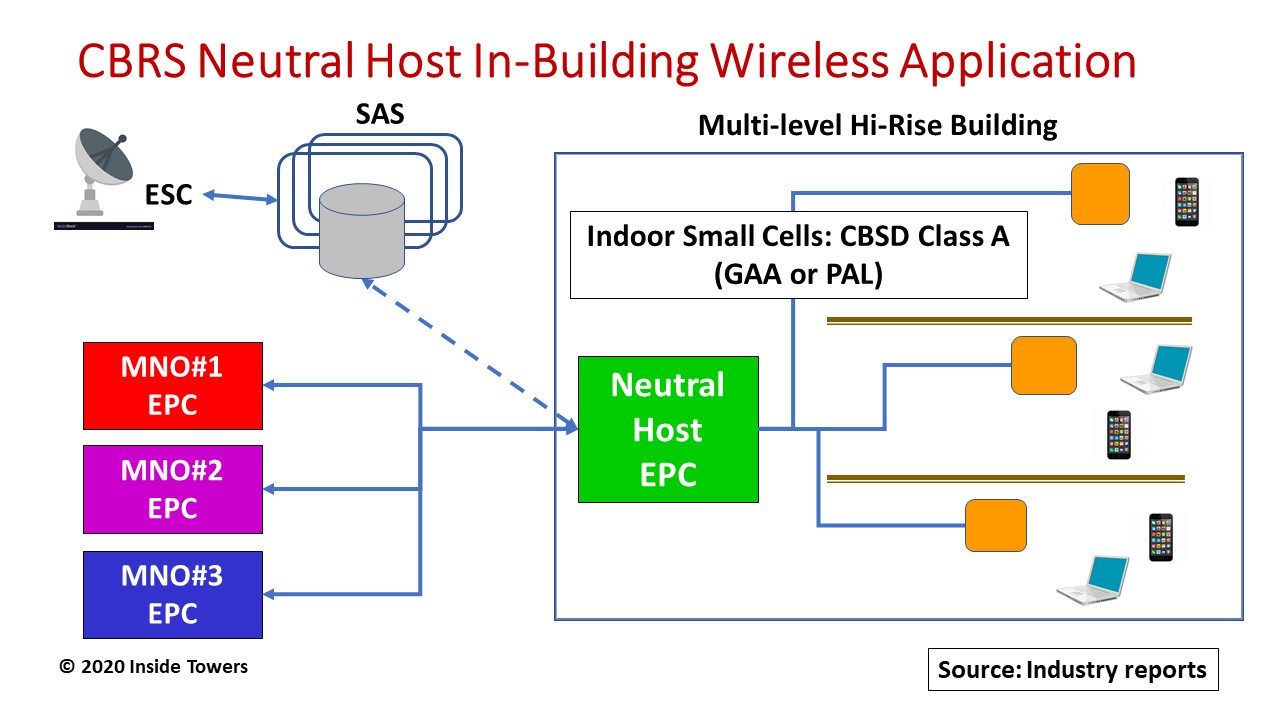CBRS in the 3.5 GHz (3550-3700 MHz) band opens possibilities for more in-building wireless applications. Private LTE deployment and operating costs in the CBRS band compare favorably with WiFi but with mobile data, mobile network operator traffic handoff, security, and Quality of Service that WiFi lacks.
Because of the shared nature of CBRS, IBW systems can be deployed without protracted negotiations with the MNOs who, up to now, dictated in which buildings their spectrum could be retransmitted.
Here’s how it works. A property owner contracts with a neutral host operator to install CBRS-enabled LTE eNodeBs at strategic points throughout the building. These small cells can operate as 3.5 GHz CBRS-only mode either with Tier 2 Priority Access License or Tier 3 General Authorized Access spectrum, or in both-mode combining the CBRS PAL and GAA spectrum along with a specific MNO LTE frequency band.
The Spectrum Access System is key to the 3.5 GHz CBRS spectrum sharing model. A SAS administrator maintains a database of all CBRS base stations, called Citizens Broadband Radio Service Devices (CBSDs) with their tier status, geographical location, and other relevant information to coordinate channel assignments and manage potential interferences. Federated Wireless, Commscope, Google and Sony are FCC-authorized SAS administrators.
To ensure the incumbent Department of Defense has continued access to the 3.5 GHz band mainly for shipborne radar systems, Environmental Sensing Capability networks have been deployed near radar sites along the U.S. coast. ESC networks inform the SAS administrators to activate a protection zone and dynamically reassign users in the area to other parts of the band, thus protecting the incumbent’s use of the spectrum while maximizing availability of CBRS spectrum across coastal areas.
Indoor applications call for a low-power CBSD Class A LTE base station. If engineered properly, indoor CBSDs should not cause interference with other 3.5 GHz users outside the building.
Three elements denote a private LTE network:
- Access to 3GPP LTE compatible spectrum, either owned or leased. In this case, CBRS PAL or GAA spectrum fits the bill.
- Dedicated infrastructure involving radio access network and evolved packet core equipment. The Class A CBSDs satisfy the RAN specifications. The neutral host EPC, either owned or leased, can be located on premise or at a remote location. The EPC manages all the user equipment traffic and links CBSDs to the SAS.
- Subscriber Identity Module cards with a private network profile, encryption, and network ID. With a CBRS SIM card added to subscriber owned smartphones, authorized subscribers connect to the private LTE network automatically. Other public MNO subscribers with CBRS-enabled smartphones could roam onto the private LTE network. Once identified as a roamer, the neutral host EPC can authenticate the call with a MNO EPC and allow connectivity but restrict proprietary access to the private LTE network.
The economics for using CBRS inside buildings are attractive. Large enterprises have traditionally relied on WiFi networks to satisfy the growing wireless data demand. But WiFi cannot provide seamless mobile data services indoors.
Distributed antenna systems are used for IBW applications involving multiple MNOs. However, DAS is considered too expensive for many enterprises. Moreover, dealing with multiple MNOs to secure signal sources for distribution throughout the building is a complicated, arduous, and invasive process that many building owners simply forgo.
Alternatively, CBSDs are installed like WiFi access points and can support both private and MNO LTE traffic. Though not a WiFi replacement, a private LTE network running enterprise- or venue-specific applications on consumer or worker UEs provide the facility owner a flexible and cost-effective set up that is fully mobile and supports QoS applications such as mission-critical manufacturing, safety, or security systems. Installed WiFi hotspots can augment network capacity.
The market potential for CBRS IBW applications is sizable. In the U.S., there are over 325,000 buildings in the 50,000-500,000 sq ft size range that are candidates for CBRS IBW deployments for private LTE network use. This so-called Middleprise comprises large buildings averaging 210,000 sq ft used in education, healthcare, hospitality, retail, office, residential, and warehouse and storage segments.
At current rates to engineer, furnish and install small cells inside buildings, the total addressable market for the Middleprise is estimated in the $25-30 billion range. With greater availability of CBRS radios and accompanying UEs, CBRS-enabled IBW systems can address a major portion of that market.
by John Celentano, Inside Towers Business Editor





Reader Interactions